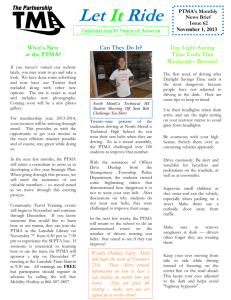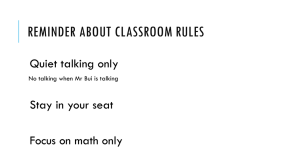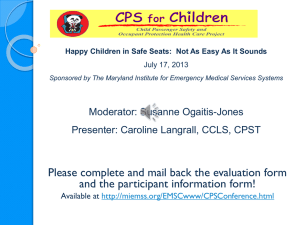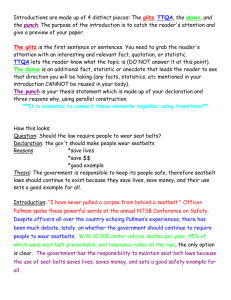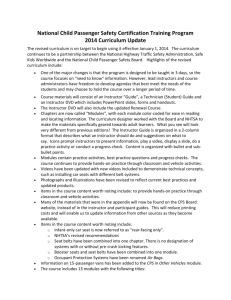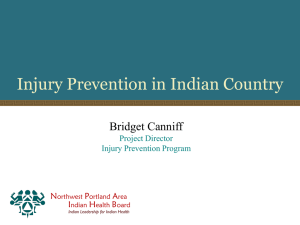PRIMECARE PEDIATRICS 15A BAYNARD PARK, NEWNAN, GA
advertisement
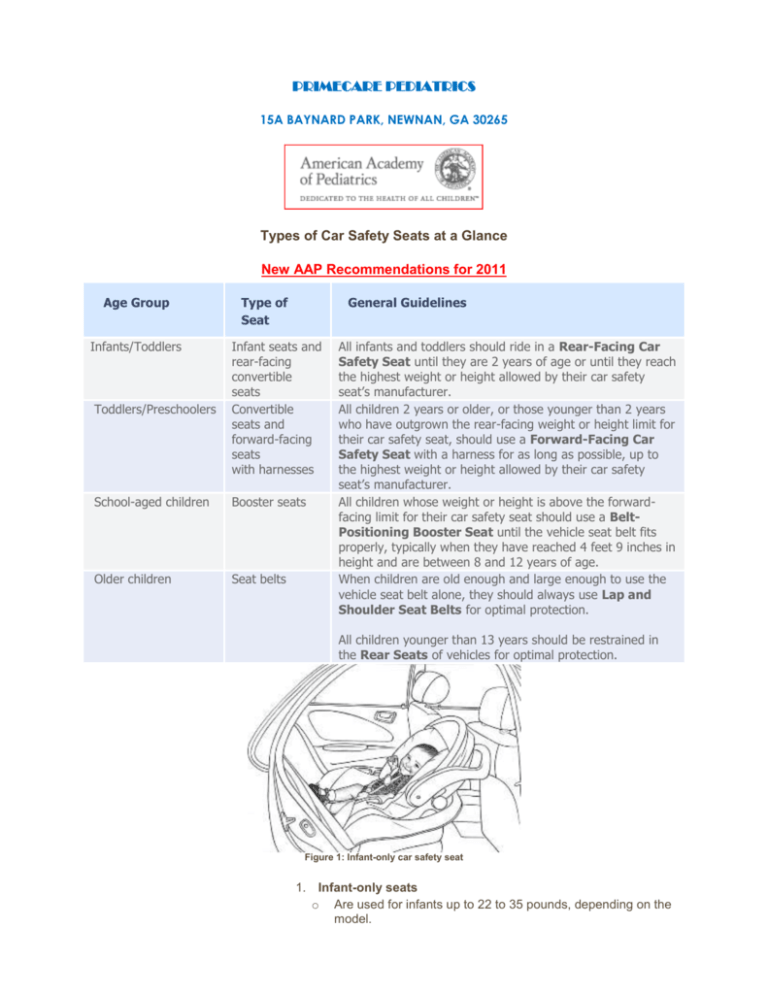
PRIMECARE PEDIATRICS 15A BAYNARD PARK, NEWNAN, GA 30265 Types of Car Safety Seats at a Glance New AAP Recommendations for 2011 Age Group Infants/Toddlers General Guidelines Type of Seat Toddlers/Preschoolers Infant seats and rear-facing convertible seats Convertible seats and forward-facing seats with harnesses School-aged children Booster seats Older children Seat belts All infants and toddlers should ride in a Rear-Facing Car Safety Seat until they are 2 years of age or until they reach the highest weight or height allowed by their car safety seat’s manufacturer. All children 2 years or older, or those younger than 2 years who have outgrown the rear-facing weight or height limit for their car safety seat, should use a Forward-Facing Car Safety Seat with a harness for as long as possible, up to the highest weight or height allowed by their car safety seat’s manufacturer. All children whose weight or height is above the forwardfacing limit for their car safety seat should use a BeltPositioning Booster Seat until the vehicle seat belt fits properly, typically when they have reached 4 feet 9 inches in height and are between 8 and 12 years of age. When children are old enough and large enough to use the vehicle seat belt alone, they should always use Lap and Shoulder Seat Belts for optimal protection. All children younger than 13 years should be restrained in the Rear Seats of vehicles for optimal protection. Figure 1: Infant-only car safety seat 1. Infant-only seats o Are used for infants up to 22 to 35 pounds, depending on the model. o Are small and have carrying handles (and sometimes come as part of a stroller system). o May come with a base that can be left in the car. The seat clicks into and out of the base so you don’t have to install the seat each time you use it. Parents can buy more than one base for additional vehicles. o Are used only for travel (not for positioning outside the vehicle). 2. Convertible seats (used rear-facing) o Can be used rear-facing, then “converted” to forward-facing for older children. This means the seat can be used longer by your child. They are bulkier than infant seats, however, and do not come with carrying handles or separate bases. o May have higher rear-facing weight (30–40 pounds) and height limits than infant-only seats, which make them ideal for bigger babies. o Usually have a 5-point harness that attaches at the shoulders, at the hips, and between the legs. Older convertible seats may have an overhead shield—a padded tray-like shield that swings down over the child. 3. 3-in-1 seats (used rear-facing) o Can be used rear-facing, forward-facing, or as a beltpositioning booster. This means the seat may be used longer by your child. o Are often bigger in size so adequate space within the vehicle when rear-facing should be determined. o Do not have the convenience of a carrying handle or a separate base; however, they may have higher rear-facing weight (35–40 pounds) and height limits than infant-only seats, which make them ideal for bigger babies. Installation tips for rear-facing seats When using a rear-facing seat, keep the following in mind: Place the harnesses in your rear-facing seat in slots that are at or below your baby’s shoulders. Ensure that the harness is snug and that the harness clip is positioned at the mid-chest level. Make sure the car safety seat is installed tightly in the vehicle. If you can move the seat at the belt path more than an inch side to side or front to back, it’s not tight enough. Never place a rear-facing car safety seat in the front seat of a vehicle that has an active front passenger air bag. If the air bag inflates, it will hit the back of the car safety seat, right where your baby’s head is, and could cause serious injury or death. Be sure you know what kind of seat belts your vehicle has. Some seat belts need locking clips to keep the belt locked into position. Locking clips come with most new car safety seats. If you’re not sure, check the owner’s manual that came with your vehicle. Locking clips are not needed in most newer vehicles, and some seats have built-in lockoffs to lock the belt. If you are using a convertible or 3-in-1 seat in the rear-facing position, make sure the seat belt is routed through the correct belt path. Check the instructions that came with the car safety seat to be sure. If your vehicle was made after 2002, it may come with the LATCH system, which is used to secure car safety seats. See below for information on using LATCH. Make sure the seat is at the correct angle so your infant’s head does not flop forward. Many seats have angle indicators or adjusters that can help prevent this. If your seat does not have an angle adjuster, tilt the car safety seat back by putting a rolled towel or other firm padding (such as a pool noodle) under the base near the point where the back and bottom of the vehicle seat meet. Still having trouble? There may be a certified child passenger safety (CPS) technician in your area who can help. If you need installation help, see below for information on how to locate a CPS technician. Common questions Q: What if my baby’s feet touch the back of the vehicle seat? A: Your child can bend his legs easily and will be comfortable in a convertible seat. Injuries to the legs are rare for children facing the rear. Q: What do I do if my baby slouches down or to the side in his car safety seat? A: Blanket rolls may be placed on both sides of the infant and a small diaper or blanket between the crotch strap and the infant. Do not place padding under or behind the infant or use any sort of car safety seat insert unless it came with the seat or was made by the manufacturer of the seat. Figure 2: Car safety seat with a small cloth between crotch strap and infant, retainer clip positioned at the midpoint of the infant’s chest, and blanket rolls on both sides of the infant. Q: Can I adjust the straps when my baby is wearing thicker clothing, like in the winter? A: Yes, but make sure the harnesses are still snug. Also remember to tighten the straps again after the thicker clothes are no longer needed. Ideally, dress your baby in thinner layers instead of a bulky coat or snowsuit, and tuck a blanket around your baby over the buckled harness straps if needed. Q: Are rear-facing convertible seats OK to use for preemies? A: Premature infants should be tested while still in the hospital to make sure they can ride safely in a reclined position. Babies who need to lie flat during travel should ride in a crash-tested car bed. Very small infants who can ride safely in a reclined position usually fit better in infant-only seats; however, if you need to use a convertible seat, choose one without a tray-shield harness. The shields often are too big and too far from the body to fit correctly and the child’s face could hit the shield in a crash. Q: What is LATCH? A: LATCH (Lower Anchors and Tethers for Children) is an attachment system for car safety seats. Lower anchors can be used instead of the seat belt to install the seat and may be easier to use in some cars. The top tether improves the safety provided by the seat and is important to use for all forward-facing seats. Read the vehicle owner’s manual and the car safety seat instructions for weight limits for lower anchors and top tethers. Vehicles with the LATCH system have anchors located in the back seat. Car safety seats that come with LATCH have attachments that fasten to these anchors. Nearly all passenger vehicles and all car safety seats made on or after September 1, 2002, come with LATCH. However, unless both your vehicle and the car safety seat have the lower anchor system, you will still need to use seat belts to install the car safety seat. Toddlers and preschoolers—forward-facing All children 2 years or older, or those younger than 2 years who have outgrown the rear-facing weight or height limit for their car safety seat, should use a Forward-Facing Car Safety Seat with a harness for as long as possible, up to the highest weight or height allowed by their car safety seat’s manufacturer. It is best for children to ride in a seat with a harness as long as possible, at least to 4 years of age. If your child outgrows his seat before reaching 4 years of age, consider using a seat with a harness approved for higher weights and heights. Figure 3: Forward-facing car safety seat Types of car safety restraints There are 5 types of car safety restraints that can be used forward-facing. 1. Convertible seats—Seats that “convert” from rear-facing to forward-facing seats. These include 3-in-1 seats. 2. Forward-facing only—These seats can be used forward-facing with a harness for children who weigh up to 40 to 80 pounds (depending on the model). 3. Combination seat with harness—These seats can be used forward-facing with a harness for children who weigh up to 40 to 80 pounds (depending on the model) or without the harness as a booster (up to 80–100 pounds). 4. Built-in seats—Some vehicles come with forward-facing seats built in. Weight and height limits vary. Read your vehicle owner’s manual or contact the manufacturer for details about how to use these seats. 5. Travel vests—These can be worn by children between 20 and 168 pounds and can be an alternative to traditional forwardfacing seats. They are useful for when a vehicle has lap-only seat belts in the rear or for children whose weight has exceeded that allowed by car safety seats. These vests may require use of a top tether. Installation tips for forward-facing seats Make sure the car safety seat is installed tightly in the vehicle and that the harness fits the child snugly. To switch a convertible or 3-in-1 seat from rear-facing to forward-facing Move the shoulder straps to the slots that are at or above your child’s shoulders. On some convertible seats, the top harness slots must be used when facing forward. Check the instructions that came with the seat to be sure. You may have to adjust the recline angle of the seat. Check the instructions to be sure. Make sure the seat belt runs through the forward-facing belt path. When making these changes, always follow the car safety seat instructions. If your vehicle was made after 2002, it should come with the LATCH system, which is used to secure car safety seats. A tether is a strap that attaches to the top of a car safety seat and to an anchor point in your vehicle (see your vehicle owner’s manual to find where the tether anchors are in your vehicle). Tethers give important extra protection by keeping the car safety seat and the child’s head from moving too far forward in a crash or sudden stop. All new cars, minivans, and light trucks have been required to have tether anchors since September 2000. New forward-facing car safety seats come with tethers. Check the car safety seat instructions and vehicle owner’s manual for information about the top weight limit and locations of the tether anchors. Common questions Q: What if I drive more children than can be buckled safely in the back seat? A: It’s best to avoid this, especially if your vehicle has air bags in the front seat. All children younger than 13 years should ride in the back seat. If absolutely necessary, a child in a forward-facing car safety seat with a harness may be the best choice to ride in front. Just be sure the vehicle seat is moved as far back away from the dashboard (and the air bag) as possible. Q: What do I need to know if my child will be driven by someone else, such as for child care or school? A: If your child is being driven by someone else, make sure The car safety seat your child will be using fits properly in the vehicle used for transport. The car safety seat being used is appropriate for the age and size of your child. The person in charge of transporting your child knows how to install and use the car safety seat correctly. Child care programs and schools should have written guidelines for transporting children. These guidelines should include the following: All drivers must have a valid driver’s license. In some states, school bus drivers need to have a special type of license. Staff-to-child ratios for transport should meet or exceed those required for the classroom. Every child should be supervised during transport, either by school staff or a parent volunteer, so the driver can focus on driving. School staff, teachers, and drivers should know what do to in an emergency, know how to properly use car safety seats and seat belts, and be aware of other safety requirements. Q: Should my child ride in a car safety seat on an airplane? A: Most infant, convertible, and forward-facing seats can be used on airplanes, but booster seats and travel vests cannot. The Federal Aviation Administration (FAA) and the AAP recommend that when flying, children should be securely fastened in certified child restraints until 4 years of age, and then should be secured with the airplane seat belts. This will help keep them safe during takeoff and landing or in case of turbulence. Check the label on your car safety seat or call the car safety seat manufacturer before you travel to see if your seat is certified for use on an airplane. You can also consider using a restraint made only for use on airplanes and approved by the FAA. School-aged children—booster seats Booster seats are for older children who have outgrown their forward-facing car safety seats. All children whose weight or height is above the forward-facing limit for their car safety seat should use a Belt-Positioning Booster Seat until the vehicle seat belt fits properly, typically when they have reached 4 feet 9 inches in height and are between 8 and 12 years of age. The owner’s manual that comes with your car safety seat will tell you the height and weight limits for the seat. As a general guideline, a child has outgrown his forward-facing seat when any one of the following is true: He reaches the top weight or height allowed for his seat with a harness. (These limits are listed on the seat and also included in the instruction booklet.) His shoulders are above the top harness slots. His ears have reached the top of the seat. Types of booster seats Booster seats are designed to raise the child up so that the lap and shoulder seat belts fit properly. High-back and backless booster seats are available. They do not come with harness straps but are used with the lap and shoulder seat belts in your vehicle, the same way an adult rides. Booster seats should be used until your child can correctly fit in lap and shoulder seat belts. Booster seats typically include a plastic clip or guide to help ensure the correct use of the vehicle lap and shoulder belts. See the instruction booklet that came with the booster seat for directions on how to use the guide or clip. Figure 4: Belt-positioning booster seat Installation tips for booster seats Booster seats must be used with a lap and shoulder belt. When using a booster seat, make sure The lap belt lies low and snug across your child’s upper thighs. The shoulder belt crosses the middle of your child’s chest and shoulder. Common questions Q: What if my car only has lap belts in the back seat? A: Lap belts work fine with infant-only, convertible, and forward-facing seats. If your car only has lap belts, use a forward-facing car safety seat with a harness and higher weight limits. Other options are Check to see if shoulder belts can be installed in your vehicle. Use a travel vest (some can be used with lap belts). Consider buying another car with lap and shoulder belts in the back seat. Q: Is there a difference between high-back and backless boosters? A: Both types of boosters are designed to raise your child so the seat belts fit properly and both will reduce your child’s risk of injury in a crash. High-back boosters are useful in vehicles that do not have head rests or have low seat backs. Many seats that look like high-back boosters are actually combination seats. They come with harnesses that can be used for smaller children and can then be removed for older children. Backless boosters are usually less expensive and are easier to move from vehicle to vehicle. Backless boosters can be safely used in vehicles with headrests and high seat backs. Older children—seat belts Seat belts are made for adults. Your child should stay in a booster seat until adult seat belts fit correctly (usually when the child reaches about 4 feet 9 inches in height and is between 8 and 12 years of age). When children are old enough and large enough to use the vehicle seat belt alone, they should always use Lap and Shoulder Seat Belts for optimal protection. Using a seat belt 1. An adult seat belt fits correctly when o The shoulder belt lies across the middle of the chest and shoulder, not the neck or throat. o The lap belt is low and snug across the upper thighs, not the belly. o Your child is tall enough to sit against the vehicle seat back with her knees bent without slouching and can stay in this position comfortably throughout the trip. 2. Other points to keep in mind when using seat belts include o Make sure your child does not tuck the shoulder belt under her arm or behind her back. This leaves the upper body unprotected, putting your child at risk of severe injury in a crash or with sudden braking. o Never allow anyone to “share” seat belts. All passengers must have their own car safety seats or seat belts. Common Questions Q: I’ve seen products that say they can help make the seat belt fit better. Should we get one of these? A: No, these products should not be used. In fact, they may actually interfere with proper seat belt fit by causing the lap belt to ride too high on the stomach and making the shoulder belt too loose. They can even damage the seat belt. This rule applies to car safety seats too; do not use any extra products unless they came with the seat. There are no federal safety standards for these products and until there are, the AAP does not recommend they be used. As long as children are riding in the correct restraint for their size, they should not need to use any additional devices. Shopping for car safety seats When shopping for a car safety seat, keep the following tips in mind: o o o o o o o o o o o No one seat is the “best” or “safest.” The best seat is the one that fits your child’s size, is correctly installed, fits well in your vehicle, and is used properly every time you drive. Don’t decide by price alone. A higher price does not mean the seat is safer or easier to use. Avoid used seats if you don’t know the seat’s history. Never use a car safety seat that Is too old. Look on the label for the date it was made. Check with the manufacturer to find out how long it recommends using the seat. Has any visible cracks on it. Does not have a label with the date of manufacture and model number. Without these, you cannot check to see if the seat has been recalled. Does not come with instructions. You need them to know how to use the seat. Is missing parts. Used car safety seats often come without important parts. Check with the manufacturer to make sure you can get the right parts. Was recalled. You can find out by calling the manufacturer or by contacting the National Highway Traffic Safety Administration (NHTSA) Vehicle Safety Hotline at 888/327-4236. You can also visit the NHTSA Web site. Do not use seats that have been in a moderate or severe crash. Seats that were in a minor crash may still be safe to use, but some car safety seat manufacturers recommend replacing the seat after any crash, even a minor one. The NHTSA considers a crash minor if all of the following are true: The vehicle could be driven away from the crash. The vehicle door closest to the car safety seat was not damaged. No one in the vehicle was injured. The air bags did not go off. You can’t see any damage to the car safety seat. If you are unsure, call the manufacturer of the seat. See "Manufacturer phone numbers and Web sites" for manufacturer contact information. About air bags Front air bags All new cars come with front air bags. When used with seat belts, air bags work very well to protect teenagers and adults. However, air bags can be very dangerous to children, particularly those riding in rear-facing car safety seats, and to preschool and young school-aged children who are not properly restrained. If your vehicle has a front passenger air bag, infants in rear-facing seats must ride in the back seat. Even in a relatively lowspeed crash, the air bag can inflate, strike the car safety seat, and cause serious brain injury and death. Vehicles with no back seat or a back seat that is not made for passengers are not the best choice for traveling with small children. However, the air bag can be turned off in some of these vehicles if the front seat is needed for a child passenger. See your vehicle owner’s manual for more information. Side air bags Side air bags improve safety for adults in side-impact crashes. Read your vehicle owner’s manual for more information about the air bags in your vehicle. Read your car safety seat manual and the vehicle owner’s manual for guidance on placing the seat next to a side air bag. If you need installation help If you have questions or need help installing your car safety seat, find a certified CPS technician. Lists of certified CPS technicians and child seat fitting stations are available on the following Web sites: NHTSA (or call NHTSA Vehicle Safety Hotline at 888/327-4236) SeatCheck (or call 866/SEATCHECK [866/732-8243]) National Child Passenger Safety Certified Technicians (or call 877/366-8154) This site provides information in Spanish and also provides a list of CPS technicians with enhanced training in protection of children with special needs. Important reminders 1. Be a good role model. Make sure you always wear your seat belt. This will help your child form a lifelong habit of buckling up. 2. Never leave your child alone in or around cars. Any of the following can happen when a child is left alone in or around a vehicle: o He can die of heat stroke because temperatures can reach deadly levels in minutes. o He can be strangled by power windows, retracting seat belts, sunroofs, or accessories. o He can knock the vehicle into gear, setting it in motion. o He can be backed over when the vehicle backs up. o He can become trapped in the trunk of the vehicle. 3. Always read and follow the manufacturer’s instructions. If you do not have the manufacturer’s instructions for your car safety seat, write or call the company’s customer service department. They will ask you for the model number, name of seat, and date of manufacture. The manufacturer’s address and phone number are on the label on the seat. Also be sure to follow the instructions in your vehicle owner’s manual about using car safety seats. Some manufacturers’ instructions may be available on their Web sites. Last Updated 3/20/2011 Source: Car Safety Seats: A Guide for Families 2011 (Copyright © 2011 American Academy of Pediatrics)
